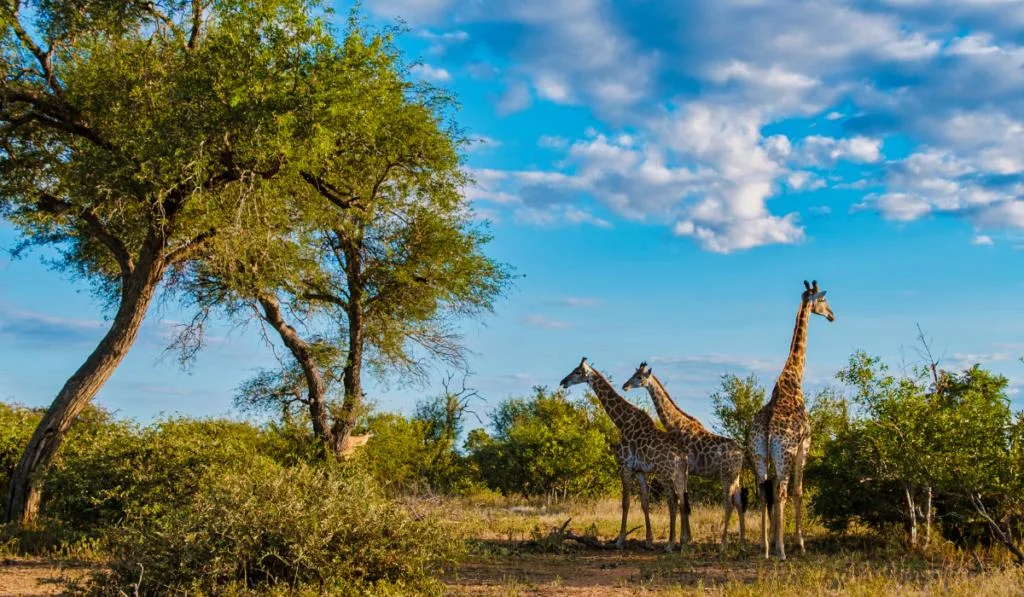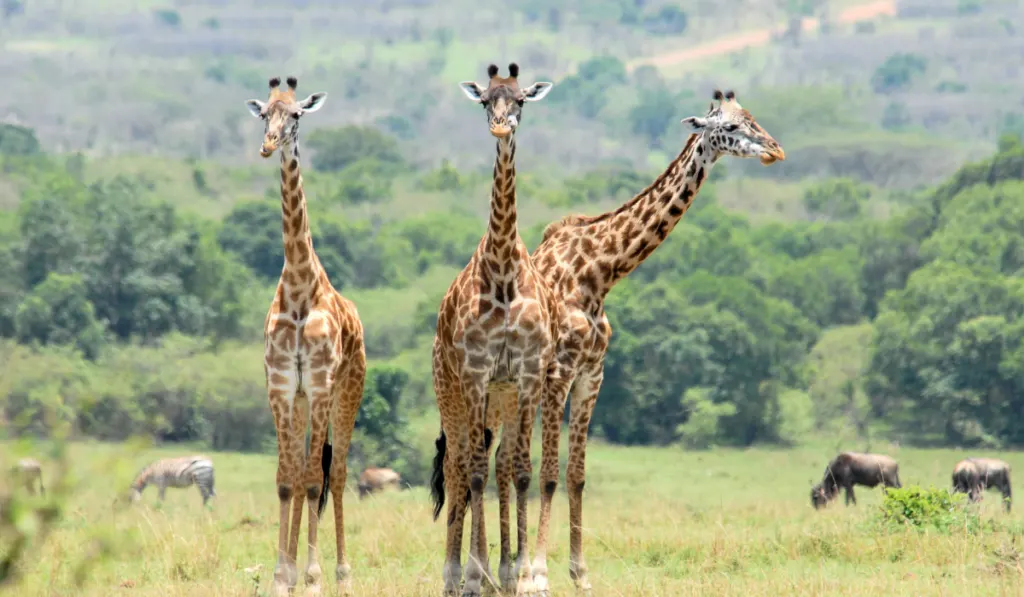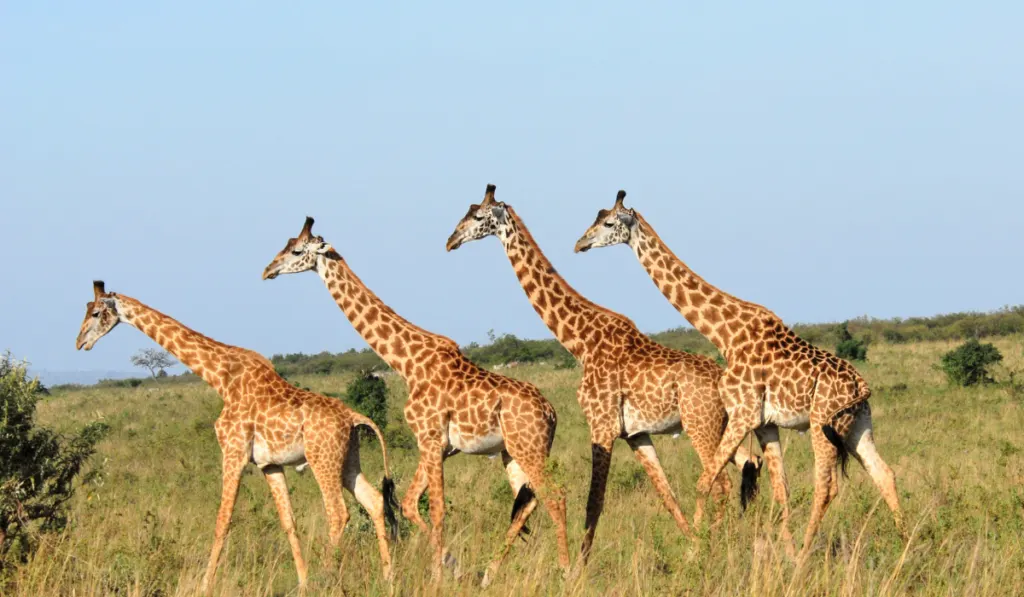The giraffe, being the tallest terrestrial mammal in the world, is one of the most fascinating animals on the planet. They can grow as high as 20 feet, and since they’re such a large animal, you might wonder if giraffes eat plants, animals, or both. Well, let’s answer that.
Are Giraffes herbivores, carnivores, or omnivores?
Giraffes are herbivores. Their diet consists of plants, leaves, twigs, fruits, and roots. Their long necks grant them easy access to seeds, fruits, leaves, and branches of trees such as mimosa and acacia trees.

At the same time, these long necks make it hard for them to graze and drink water.
In this article, we will touch on the diet of giraffes, how they feed, what they drink, and where they live.
Table of Contents
What Is the Difference Between Herbivores, Carnivores, and Omnivores?
Animal species differ from each other in many ways, especially diet. Going by what they eat, animals can be classified into three classes. They can either be omnivores, herbivores, or carnivores.
Herbivores
Herbivores are animals whose diet consists of only plants. They can have simple or complex stomachs. Those with complex or polygastric stomachs are called ruminant herbivores.
Compared to omnivores and carnivores, herbivores have long digestive tracts. In some cases, their digestive tracts are 10 times as long as their body.
Herbivores have amylase in their saliva. Their stomach pH typically falls between 3 and 7. However, they cannot process vitamin A.
The dental structure of an herbivore consists of flat molars that are almost square-shaped. This set of teeth are cut out for crushing, chewing, and grinding.
Carnivores
The diet of carnivores consists mainly of animal matter. Carnivores have simple stomachs, which are typically very acidic and have a pH range of 1-2.
The digestive tract of a carnivore is typically the shortest. Carnivores have no digestive enzymes in their saliva, and they can process vitamin A.
Carnivores have canine, incisor, and molar teeth in their mouth. The canine teeth sit in the anterior parts of their mouth, and they are meant for tearing into meat.
The incisors are also in the anterior parts of their mouth right between the canine, and they are for cutting meat.

In some cases, carnivores have a few molar teeth in the back of their mouth.
Omnivores
Omnivores eat both plants and animals, and they have simple stomachs.
The digestive tract of omnivores is typically medium-length. In other words, an omnivore’s digestive tract is relatively longer than that of a carnivore. But it is shorter than that of an herbivore.
The stomach of an omnivore is usually very acidic since its pH falls within the range of 1-4. Their saliva contains amylase, and they can metabolize vitamin A.
In an omnivore’s mouth, there are incisor, canine, molar, and premolar teeth. The canine and incisor sit at the front, and they are used for tearing and cutting, respectively.
The premolars sit behind the canine teeth, while the molars sit behind the premolars. Both are suited for grinding.
What Foods Do Giraffes Eat in the Wild?
Giraffes are known as browser eaters; they feed on plant matter in trees, shrubs, or other plants above ground. They like to eat herbs and vines but are more likely to eat flowers and fruits when they are in season.
The diet of giraffes usually contains a low proportion of grass because their long necks make it easier to browse than graze.
Giraffes have long tongues, and the roof of their mouth is quite strong. These features facilitate their feeding and make it easy for them to feed on various types of leaves and shoots.
Giraffes often adapt their diet to the type of food available in the habitat they find themselves. They also adjust their diet as the seasons change.
For instance, in southern and eastern Africa, giraffes will eat deciduous trees, shrubs, and vines in wet seasons. But in the dry season, they feed on evergreen species near streams and rivers.
When in the wild and captivity, giraffes prefer eating the leaves of the acacia tree. These trees have long thorns all over the leaves. While these thorns discourage other animals, giraffes can elude them with their long tongues.

Giraffes also have markedly thick saliva. So, if they ever swallow a thorn, the saliva protects the lining of their digestive system.
Giraffes spend a significant part of their day feeding. On average, they are estimated to spend 75% of the year feeding. They spend more time searching for food during the dry season than during the wet season. It’s not hard to guess why.
The average adult giraffe can consume around 75 pounds of food in a day.
Giraffes are active in the dark; when the moon is out, they eat a whole lot more, and when there’s no moon, they ruminate more.
What Do Giraffes Drink?
While eating for giraffes is easy, drinking can be a problem for them. Their long necks pose a serious challenge when they are trying to hydrate themselves. This, in turn, makes them vulnerable to predators in the wild.
Giraffes will not bend their necks over a watering hole like many other quadrupeds. Instead, they spread their legs and bend their knees to reach water. Luckily, giraffes don’t need to do this often because they can go on for days without water.
Acacia leaves alongside other roots and leaves consumed by giraffes contain considerable amounts of water. Hence, the ability of giraffes to survive for days without water.

When in captivity and when water is abundant, giraffes can drink as much as ten gallons a day.
Where Do Giraffes Live?
Giraffes can be found in various habitats like the savanna, grasslands, or open woodlands. They commonly stay in areas with large numbers of acacia trees.
Most giraffe habitats are found in East Africa, Angola, Zambia, and in the southwestern part of Africa.
Before the middle of the 20th century, giraffes had significantly high populations in West Africa and in the south of the Sahara. As time passed, their numbers fell rapidly, and their population has become highly fragmented.
Giraffes are known to thrive in areas with hot climatic conditions. They like open spaces – places where they can easily sense the presence of a predator from a distance.
Such open spaces make it easy for giraffes to flee when they have to.
During the rainy season, food is in excess, so giraffes spread out more to graze. But during seasons where food is limited, they muster around the leftover green trees and shrubs.
Conclusion
Giraffes are herbivores. They are built to seek their foliage from plant structures above the ground. So, they’ll commonly eat plant matter from trees and shrubs. This is why they are browsers, and this is why they rarely eat grass.
Resources
- https://giraffeconservation.org/facts/how-much-do-giraffe-eat-in-a-day-what-does-their-diet-consist-of/
- https://sciencing.com/what-do-giraffes-eat-4574400.html
- https://africafreak.com/what-do-giraffes-eat
- https://www.giraffeworlds.com/giraffe-habitat/
- https://animalcorner.org/animals/giraffe/
- https://en.wikipedia.org/wiki/Giraffe#Behaviour_and_ecology
- https://pediaa.com/difference-between-herbivores-carnivores-and-omnivores/
- https://www.edenpetfoods.com/nutrition/herbivores-omnivores-and-carnivores-explained.html
